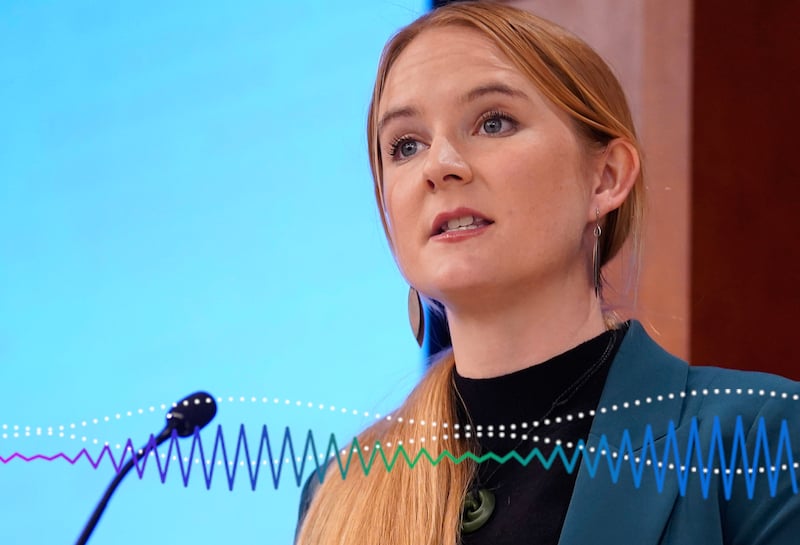
William Maloney: The Innovation Paradox
In This Episode
While technology is reshaping economies around the world, a recent book published by the World Bank suggests developing countries are missing out on a huge opportunity. In this podcast, economist William Maloney, says the potential returns on investment into Research and Development by developing countries are astounding, and could dwarf international aid flows. Yet, developing country firms and governments invest very little toward realizing this potential. Maloney is Chief Economist for Equitable Growth, Finance and Institutions in the World Bank Group, and co-author of The Innovation Paradox. He was a guest lecturer at the IMF’s Developing Economies Seminar Series.
Hello, I’m Bruce Edwards and welcome to this podcast produced by the International Monetary Fund. In this program: World Bank economist, William Maloney, tells us why developing countries would do well to take advantage of recent innovations and tap in to the massive stock of global know-how.
MR. MALONEY [soundbite]: We should see developing country firms being extremely aggressive at adopting these technologies and investing in R&D, and we should see governments thinking basically about nothing else—and we see neither.
MR. EDWARDS: We hear a lot about how technology is reshaping economies around the world. But, a recent book published by the World Bank suggests developing countries are missing out on a huge opportunity. Maloney says the potential returns on investment into research and development by developing countries are astounding and could dwarf international aid flows. Yet, developing country firms and governments invest very little toward realizing this potential.
William Maloney is Chief Economist for Equitable Growth, Finance and Institutions in the World Bank Group, and co-author of The Innovation Paradox. He was a guest lecturer at the IMF’s Developing Economies Seminar Series.
Describe to me, the innovation paradox that you refer to in your research, as compared to, perhaps, the productivity paradox that we’ve been hearing about.
MR. MALONEY: So, these are different animals. The productivity paradox arises from the fact that we’ve had all these huge advances in information and telecommunications technology and we see that everywhere except in the productivity numbers. So, that’s the productivity paradox. The innovation paradox is that rates of return to investments and innovation of various different kinds appear to be extremely high, much higher for poor countries than for rich countries, yet we see a much smaller effort in these areas.
So, how do we get poor countries to adopt the technologies that now exist in the advanced countries which can raise their productivity? It’s not about inventing new things, it’s about the ability of countries to identify ideas that could work to bring them to their countries, to adapt them, and to generate growth with them.
MR. EDWARDS: And, are they managing to do that?
MR. MALONEY: No. This is exactly the paradox that we’re talking about in the book. If you actually think that, more or less, half of growth is productivity growth—total factor productivity—and somewhere around half of that is within firm improvements in productivity, then we’re talking enormous amounts of money that dwarf foreign aid flows of any kind. And, hence, we would think that countries would be narrowly focused on exactly the search for new technologies and increasing the productivity of the private sector. But, by every measure that we look at, that's not the case.
MR. EDWARDS: So, generally the amount on average a country might put towards research and development, does it vary a lot between advanced economies and developing ones?
MR. MALONEY: Hugely. Your average rich country will spend somewhere around 2 and 4 percent of GDP on research and development. Your poorest countries will spend close to nothing. So, for instance, in many Latin American countries you'll find it’s .1 or .2 percent of GDP, whereas in Korea, for instance, it’s somewhere between 3 and 4 percent. You could say, okay, but that’s higher order spending, that’s including invention, which it does. It also includes adoption of technologies. But, even if we look at other measures of technological adoption, for instance, purchasing of existing licenses to use technologies abroad, that also increases with GDP. So, poor countries are spending very little on adopting existing technologies through that channel.
And, there is another dimension that we focus on which is what we call “managerial technologies.” You can think of adopting good managing practices as a kind of importing of best practice technologies from abroad. You can say, well what are we talking about here? Well, do you have a good set of accounts? Do you have capacity or systems set up to take a longer run view on where your firm should be? Do you have staff that can help you get there? If you’re actually thinking about doing any sort of innovation, do you have a human resources policy that will help you staff that plan? And in all of this, do you have established feedback loops to ensure that you’re getting where you want to go? Very well managed companies have all of those things. We find, again, that most poor countries have very weak managerial practices. Hence, they don’t have the capability to identify new technologies.
MR. EDWARDS: But, what kind of rates of return are we talking about?
MR. MALONEY: So, in the advanced countries, let’s say the US and Spain—those are the countries for which we have the best estimates to date—they are somewhere between 30 to 45 percent. This is social rates of return, meaning it doesn’t necessarily accrue to the person doing it, it’s to society as a whole. If you believe these results, and I think we should, the United States should probably be investing twice what it does in R&D [research and development].
The second part of this little puzzle though, is that an influential paper several years ago showed that as you get further from the technological frontier within Europe, within the OECD …
MR. EDWARDS: What do you mean by the technological frontier?
MR. MALONEY: So, the countries that are most technologically advanced, let’s say. As you get further and further from there, the potential for adopting new technologies and moving really quickly ahead gets higher and higher. So, the returns to those investments and innovation in R&D also get higher and higher. And, this we do see within the OECD [Organisation for Economic Co-operation and Development]—that Spain and those countries have higher rates of return than, say, the United States. If you extrapolate out of this sample to even Indonesia and Korea, the rates get even higher. So, we’re in the hundreds, and if you go on to Africa it is like 300 or 400 percent.
So, the question is: assuming that the rates get higher as you get further from the frontier, we should see developing country firms being extremely aggressive in adopting these technologies and investing in R&D, and we should see governments thinking basically about nothing else and just saying: okay how am I going to get my firms to do this? How can I help them do that? And, we see neither.
MR. EDWARDS: Wow. So, 400 percent return—why do you think there is such little investment toward the research and development?
MR. MALONEY: Right. So, a lot of it is, again, the absence of these complementary factors, such as having a qualified workforce; having access to credit markets that would allow you to buy physical capital; access to foreign markets because your trade regime is distorted; a competitive regime, for instance, where state-owned enterprises are absorbing all the oxygen from your entrepreneurial sector. Any number of things like these will make it so that an investment in research and development by a firm will not get the rate of return that you would think it should get given how far away it is from the technological frontier.
MR. EDWARDS: So, what you’re describing are problems that developing countries have been having for a long time. But, do you think it is realistic to think that they can build a foundation upon which they can start investing in R&D?
MR. MALONEY: So, the first thing to do is acknowledge that the innovation agenda that we have in the advanced countries is much more narrow than any innovation agenda that we face in developing countries. If you’re Sweden, you can afford to say: okay, what is the problem with my innovation system? The standard problem there is that, if Bruce has a really good idea and he spends a lot of money generating this idea, he can’t prevent me from stealing that idea. So, that means a whole bunch of people can take it. It’s what we call an “appropriability failure.” Meaning, your idea doesn’t get used up so any of us can use it and we’ll cut into your profit margins, so the rate of return you see is far below what the society as a whole could get.
Then, you want to subsidize R&D or have patents or tax write-offs or something like that, that brings the private rate of return to that R&D closer to the social rate of return. So, that’s what we do. That’s a standard concern in the advanced countries.
What I was just describing, though, is that in the developing countries, we need to think not only about barriers to accumulating knowledge capital, we have to think about all the barriers to accumulating all of the complementary factors—the physical capital. So, if I have a lousy education system, it doesn’t matter if I get a high-tech firm because there won’t be any workers to staff it. So, you have to think about all of these dimensions when you think about what we call “the national innovation system”—the system of institutions and people that generate or identify new ideas and bring them to a country. It’s a much more complex problem. You have to think about a lot of different markets that aren’t working—education markets, credit markets, your trade regime—all that stuff matters. And that is a task that gets harder and harder making sure all those things work exactly right as you get further from the frontier because we find that government capacity to actually resolve issues gets weaker and weaker.
MR. EDWARDS: But, the returns are significantly higher if they manage to get it done?
MR. MALONEY: Right, but these other problems start getting larger and larger. At some point, we find the curve bends over. So, for very poor countries, the rates of return of R&D could potentially be negative. How could they be negative? Because instead of investing in R&D you should be investing in basic education. So, it is exactly that kind of horse race—yes, as I get further away there are greater opportunities, but on the other hand, I’m less capable of actually taking advantage of them, and that causes this bend over of the returns curve.
So, exactly the challenge is to find ways for governments with limited bandwidth—let’s be honest about our capabilities to actually move the innovation agenda forward in meaningful ways.
MR. EDWARDS: So, do you think generally there is just a lack of awareness among policymakers in developing countries? Do you think that if they were more aware of this lost opportunity, they would be putting more effort towards building policies that will work in the long run?
MR. MALONEY: I think there’s an awareness abstractly that this is important, but it happens in a funny way: [they say] oh yes, artificial intelligence—we have to be there or we need to be the internet of things. Okay, some countries definitely need to be there, and maybe there are some countries that can leapfrog from wherever they are to get there. But, it is important to remember, for instance, that there are a lot of things that countries can do, that firms can do, that are much less … let’s call it “sexy.” Just making my firm work better. And, you can get huge returns without doing anything shiny.
There was a very important study in India by Nick Bloom and David McKenzie and other associates, where they took 20 textile firms and they divided them into two groups. In one of them they had Accenture Consulting come in and benchmark them. After one year, they saw improvements in productivity of 11 percent, which could pay for the entire program. There was no introducing of A.I. or anything, it was just, okay: let’s organize how our raw materials are stored. Do we have good records of what each person is producing so that when there is a defect, I can find out which worker or which manager is responsible and I can go deal with it.
Those things sound basic, but most of the firms in our developing countries don’t have those capabilities well established. I think there is a little bit of a twisting or distortion of the agenda towards these hot areas when there are huge returns to be had by much more prosaic forms of innovation.
MR. EDWARDS: That was William Maloney, Chief Economist for Equitable Growth, Finance and Institutions in the World Bank Group, and co-author of The Innovation Paradox in Developing-Country Capabilities and the Unrealized Promise of Technological Catch-Up, published by the World Bank.
If you like this podcast, subscribe on iTunes or on your favorite podcast app. Just search for “IMF Podcasts.” You can now also follow us on Twitter: @imf_podcast.
Join Us on Every Major Platform
Latest Podcasts
BEHIND THE MIC

Bruce Edwards
International Monetary Fund
Bruce Edwards produces the IMF podcast program. He's an award-winning audio producer and journalist who's covered armed conflicts, social unrest, and natural disasters from all corners of the world. He believes economists have an important role in solving the world's problems and aspires to showcase their research in every IMF podcast.

Rhoda Metcalfe
RHODA METCALFE is an independent journalist and audio producer.










